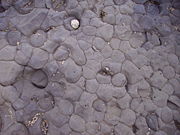
Mudstone
Encyclopedia

Sedimentary rock
Sedimentary rock are types of rock that are formed by the deposition of material at the Earth's surface and within bodies of water. Sedimentation is the collective name for processes that cause mineral and/or organic particles to settle and accumulate or minerals to precipitate from a solution....
whose original constituents were clays or mud
Mud
Mud is a mixture of water and some combination of soil, silt, and clay. Ancient mud deposits harden over geological time to form sedimentary rock such as shale or mudstone . When geological deposits of mud are formed in estuaries the resultant layers are termed bay muds...
s. Grain size is up to 0.0625 mm (0.0025 in) with individual grains too small to be distinguished without a microscope. With increased pressure over time the platey clay minerals
Clay minerals
Clay minerals are hydrous aluminium phyllosilicates, sometimes with variable amounts of iron, magnesium, alkali metals, alkaline earths, and other cations. Clays have structures similar to the micas and therefore form flat hexagonal sheets. Clay minerals are common weathering products and low...
may become aligned, with the appearance of fissility
Fissility (geology)
Fissility refers to the property of rocks to split along planes of weakness into thin sheets. This is commonly observed in shales, which are sedimentary rocks, and in slates and phyllites, which are foliated metamorphic rocks. The fissility in these rocks is caused by the preferred alignment of...
or parallel layering. This finely bedded material that splits readily into thin layers is called shale
Shale
Shale is a fine-grained, clastic sedimentary rock composed of mud that is a mix of flakes of clay minerals and tiny fragments of other minerals, especially quartz and calcite. The ratio of clay to other minerals is variable. Shale is characterized by breaks along thin laminae or parallel layering...
, as distinct from mudstone. The lack of fissility or layering in mudstone may be due either to original texture or to the disruption of layering by burrowing organisms in the sediment prior to lithification. Mud rocks, such as mudstone and shale comprise some 65% of all sedimentary rocks. Mudstone looks like hardened clay
Clay
Clay is a general term including many combinations of one or more clay minerals with traces of metal oxides and organic matter. Geologic clay deposits are mostly composed of phyllosilicate minerals containing variable amounts of water trapped in the mineral structure.- Formation :Clay minerals...
and, depending upon circumstances under which it was formed, it may show cracks or fissures, like a sun-baked clay deposit.
They can be separated into these categories:
- SiltstoneSiltstoneSiltstone is a sedimentary rock which has a grain size in the silt range, finer than sandstone and coarser than claystones.- Description :As its name implies, it is primarily composed of silt sized particles, defined as grains 1/16 - 1/256 mm or 4 to 8 on the Krumbein phi scale...
- greater than half of the composition is silt-sized particles. - ClaystoneClaystoneClaystone is a geological term used to describe a clastic sedimentary rock that is composed primarily of clay-sized particles ....
- greater than half of the composition is clay-sized particles. - Mudstone - hardened mud; a mix of silt and clay sized particles. Mudstone can include:
- ShaleShaleShale is a fine-grained, clastic sedimentary rock composed of mud that is a mix of flakes of clay minerals and tiny fragments of other minerals, especially quartz and calcite. The ratio of clay to other minerals is variable. Shale is characterized by breaks along thin laminae or parallel layering...
- exhibits lamination or fissility. - ArgilliteArgilliteAn argillite is a fine-grained sedimentary rock composed predominantly of indurated clay particles. Argillaceous rocks are basically lithified muds and oozes. They contain variable amounts of silt-sized particles. The argillites grade into shale when the fissile layering typical of shale is...
- has undergone low grade metamorphism.
- Shale
Dunham classification of limestones
In the Dunham classificationDunham classification
The Dunham classification system for carbonate sedimentary rocks was devised by Robert J. Dunham in 1964, and refined by Embry and Klovan in 1971 to include sediments that were organically bound during deposition.-History:...
of limestone
Limestone
Limestone is a sedimentary rock composed largely of the minerals calcite and aragonite, which are different crystal forms of calcium carbonate . Many limestones are composed from skeletal fragments of marine organisms such as coral or foraminifera....
s, a mudstone is a matrix-supported carbonate rock
Carbonate rock
Carbonate rocks are a class of sedimentary rocks composed primarily of carbonate minerals. The two major types are limestone, which is composed of calcite or aragonite and dolostone, which is composed of the mineral dolomite .Calcite can be either dissolved by groundwater or precipitated by...
that contains less than 10% allochems
Allochems
Allochem is a term introduced by Folk to describe the recognisable 'grains' in carbonate rocks. Any fragment from around ½mm upwards in size may be considered an allochem. Examples would include ooids, peloids, oncolites, pellets, fossil or pre-existing carbonate fragments...
in a carbonate mud matrix. As defined by the Dunham classification, a mudstone is more or less synonymous with calcilutite
Calcilutite
Calcilutite is a type of limestone that is composed of predominately, more than 50 percent, of either clay-size or both silt-size and clay-size detrital carbonate grains. These grains consist either of fossil fragments, ooids, intraclasts, pellets, other grains, or some combination of them...
.

